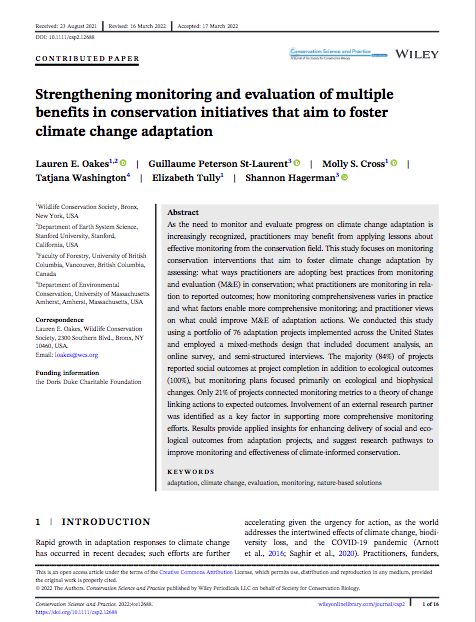Science & Planning Resources for Adaptation
Featured Peer Reviewed Publications
General adaptation knowledge and tools
America Adapts Podcast explores the challenges presenting by adapting to climate change and approaches that are already working. Episodes feature scientists, activists, policymakers and journalists. https://www.americaadapts.org/episodes
The Climate Adaptation Knowledge Exchange (CAKE) is a clearinghouse for a wide variety of information about climate adaptation. http://www.cakex.org/
Through its Conservation Gateway portal, The Nature Conservancy provides datasets, analyses, and spatial mapping for the resilience of terrestrial landscapes in the Northeast and Southeast United States, as well as other important science and information on climate change and resilience: https://www.conservationgateway.org/ConservationByGeography/NorthAmerica/UnitedStates/edc/r eportsdata/terrestrial/resilience/Pages/default.aspx
The Adaptation Workbook from the U.S. Forest Service’s Northern Institute for Applied Climate Science offers an easy to use, interactive and self-‐guided tool that creates a custom adaptation plan for forest management and conservation: http://adaptationworkbook.org
USDA Climate Hubs contains resources by region and by climate impact. https://www.climatehubs.usda.gov/index.php/
USGS Climate Adaptation Science Centers
The U.S. National Climate Assessment summarizes the impacts of climate change on the United States. https://nca2018.globalchange.gov/
Databasin houses numerous databases related to climate change vulnerability and impact assessment, and adaptation. http://www.databasin.org
AdaptWest is a spatial database and synthesis of methods for conservation planning aimed at enhancing resilience and adaptation potential of natural systems under climate change, for Western North America. http://adaptwest.databasin.org/
The Yale Mapping Framework offers a menu of approaches appropriate for ecological assessments that support conservation planning in a changing climate. It provides guidance on appropriate strategies for climate-‐smart ecological assessments and the tools to implement them. http://www.databasin.org/yale
ITEP’s Tribes and Climate Change Program training, planning and science resources http://www7.nau.edu/itep/main/tcc/
Global Adaptation Index. Free and open source, the ND-GAIN Country Index uses two decades of data across 45 indicators to rank 181 countries annually based upon their vulnerability and their readiness to successfully adapt. https://gain.nd.edu/our-work/country-index/
Urban Adaptation Assessment measures the climate risk and readiness of 278 U.S. cities. UAA climate hazards include flooding, extreme heat, extreme cold, drought, and sea-level rise. https://gain-uaa.nd.edu/?referrer=gain.nd.edu
TNC’s Resilient Land Mapping Tool https://maps.tnc.org/resilientland/
TNC’s Migrations in Motion. This map shows the average direction mammals, birds, and amphibians need to move to track hospitable climates as they shift across the landscape. https://maps.tnc.org/migrations-in-motion/#4/19.00/-78.00
BIA Tribal Climate Resilience Program training, planning and science resources. https://www.bia.gov/bia/ots/tribal-climate-resilience-program
NOAA Climate Resilience Toolkit https://toolkit.climate.gov/
Georgetown Climate Center’s Adaptation Clearinghouse. https://www.adaptationclearinghouse.org/
Climate Science Alliance’s Convenings and Trainings.https://www.climatesciencealliance.org/trainings-and-events
local and regional resources and tools from grant partners
Arctic Vessel Monitoring and Geofencing | Informational flyer with contact information
Exploring Impacts and Solutions to a Floodplain Forest within the Mississippi National River and Recreation Area | Website and lesson plan for elementary and middle school aged students
Tree tagging 101 - How to tag and register a tree in “Collector” | Instructional video
“No Net Loss” Creating new habitat for seabirds, matching acre for acre, what is currently being lost to sea level rise. | Website with resources on avian relocation and predator exclusion fencing
Tree Planting Guide: Reforestation on private lands in Front Range burn areas | Informational handout
Post-Fire Restoration and Resilience: Wildfire Resilience Workshop Series | Workshop summary
Restoring Forests for the Future: Profiles in climate-smart restoration in America’s National Forests | Collection of case studies
Red Spruce Climate Change Workshop | Agenda and links to panel talks and presentations
Conduct an Inoculant-Supported Restoration (I-SR) Project | Technical report and Informational Handout
Playa Restoration | Tools, maps, and guide
Restoring & Maintaining Healthy Playas | Informational handout
From Planning to Planting, Climate-driven Land Protection and Stewardship Strategies | Webinar presentation
Growing through change: Sourcing Climate-Resilient Seed for Ecological Restoration | Recorded Workshop
Growing Through Change, Seed Sourcing for Climate Resilience | Guide video
California Prescribed Burn Association: California’s hub for Prescribed Burn Associations and community based burning | Informational website
Vulnerability Assessment Summaries and Priority Drought-resilience strategies in the Mancos Watershed | Report and Guide
Restoring Native Plants to Navajo Lands | Handbook
Building Resiliency with Native Seeds | Management recommendations from Navajo Nation
Restoration with Native Plants | Informational Website
Resource Guide for private landowners interested in implementing prescribed burning | Handout
Pollinators & Climate Change: Making and Impact on the Farm | Webinar
Designing Diversity: Climate-Smart Habitat Management for Pollinators | Webinar
Developing your own “Sacred Grounds” program | Example action plan
JOINT MITIGation and adaptation resources
Climate Policy Info Hub: Scientific Knowledge for Decision-makers: http://climatepolicyinfohub.eu/mitigation-co-benefits-and-interlinkages-adaptation
An Interview with Scientist Bruno Locatelli on Improving the Design of Climate Change Projects: https://forestsnews.cifor.org/47876/time-to-get-it-together-on-mitigation-and-adaptation?fnl=en
Klein, R.J.T., S. Huq, F. Denton, T.E. Downing, R.G. Richels, J.B. Robinson, F.L. Toth (2007). Inter-relationships between adaptation and mitigation. Climate Change 2007: Impacts, Adaptation and Vulnerability. Contribution of Working Group II to the Fourth Assessment Report of the Intergovernmental Panel on Climate Change, M.L. Parry, O.F. Canziani, J.P. Palutikof, P.J. van der Linden and C.E. Hanson, Eds., Cambridge University Press, Cambridge, UK, 745–777.
Kongsager, R. (2018). Linking Climate Change Adaptation and Mitigation: A Review with Evidence from the Land-Use Sectors. Land, 7(4), 158.
Kongsager, R., Locatelli, B., & Chazarin, F. (2016). Addressing climate change mitigation and adaptation together: A global assessment of agriculture and forestry projects. Environmental management, 57(2), 271-282.
Locatelli, B., Evans, V., Wardell, A., Andrade, A., & Vignola, R. (2011). Forests and climate change in Latin America: linking adaptation and mitigation. Forests , 2 (1), 431-450.
Locatelli, B., Fedele, G., Fayolle, V., & Baglee, A. (2016). Synergies between adaptation and mitigation in climate change finance. International Journal of Climate Change Strategies and Management , 8 (1), 112-128.
Mason, N. W., Ausseil, A. G. E., Dymond, J. R., Overton, J. M., Price, R., & Carswell, F. E. (2012). Will use of non-biodiversity objectives to select areas for ecological restoration always compromise biodiversity gains?. Biological Conservation , 155 , 157-168.
Nordic Council of Ministers. (2017). Mitigation and Adaptation Synergies in the NDCs. Nordic Council of Ministers, Denmark. Available at: https://www.norden.org/en/publication/mitigation-adaptation-synergies-ndcs
Swart, R. O. B., & Raes, F. (2007). Making integration of adaptation and mitigation work: mainstreaming into sustainable development policies?. Climate policy, 7(4), 288-303.
Selected literature
Anderson, C., C. Field, and K. Mach. (2017) Forest Offsets Partner Climate-Change Mitigation with Conservation. Frontiers in Ecology and the Environment 15(7): 359-365.
Anderson, L., P. Glick, S. Heyck-‐Williams, and J. Murphy. (2016) Changing Tides: How Sea-‐Level Rise Harms Wildlife and Recreation Economies Along the U.S. Eastern Seaboard. National Wildlife Federation.
Anderson, M.G., M. Clark, and A. Olivero Sheldon. (2012). Resilient Sites for Terrestrial Conservation in the Northeast and Mid-‐Atlantic Region. The Nature Conservancy, Eastern Conservation Science. 168 pp.
Anderson, M.G., A. Barnett, M. Clark, C. Ferree, A. Olivero Sheldon, and J. Prince. (2014). Resilient Sites for Terrestrial Conservation in the Southeast Region. The Nature Conservancy, Eastern Conservation Science. 127 pp.
Anderson, M. G., & Ferree, C. E. (2010). Conserving the Stage: Climate Change and the Geophysical Underpinnings of Species Diversity. PLoS ONE, 5 (7), e11554.
Beier, P., & Brost, B. (2010). Use of Land Facets to Plan for Climate Change: Conserving the Arenas, Not the Actors. Conservation Biology, 24 (3), 701–710.
Beier, P., M.L. Hunter, M. Anderson (2015). Introduction to Special Section on Conserving Nature’s Stage. Conservation Biology 29: 613–617.
Butt, N., H.P. Possingham, C. De Los Rios, R. Maggini, R.A. Fuller, S.L., Maxwell, J.E.M. Watson. (2016). Challenges in assessing the vulnerability of species to climate change to inform conservation actions. Biological Conservation, 199: p. 10‐15.
Cross, M.S., et al., (2013). Accelerating Adaptation of Natural Resource Management to Address Climate Change. Conservation Biology, 27(1): p. 4‐13.
Cross, M., J. Nordgren, D. Long (2019). Managing Risks to Conservation Investments Through Climate Adaptation: A practical guide for funders. Wildlife Conservation Society. New York, NY.
Cross, M., E. Rowland, D. Long, E. Tully, K. Dunning (2017). 14 Solutions to Problems Climate Change Poses to Conservation: Examples from the WCS Climate Adaptation Fund. Wildlife Conservation Society, New York, NY.
Cross, M., E. Rowland, E. Tully, L. Oakes, D. Long (2018). Embracing Change: Adapting Conservation Approaches to Address a Changing Climate. Wildlife Conservation Society. New York, NY.
Galik, C. and R. Jackson (2009). Risks to Forest Carbon Offset Projects in a Changing Climate. Forest Ecology and Management 257: 2209-2216.
Girvetz, E.H., et al., (2009). Applied Climate-‐Change Analysis: The Climate Wizard Tool. PLoS ONE, 4(12): p. e8320.
Griscom, B. W., et al. (2017). Natural climate solutions. Proceedings of the National Academy of Sciences 114: 11645.
Hansen, L.J. & Hoffman, J.R. (2011). Climate Savvy: Adapting conservation and resource management to a changing world. Island Press. 245 pp
Heller, N., & Zavaleta, E. (2009). Biodiversity Management in the face of climate change: A review of 22 years of recommendations. Biological Conservation, (142), p. 14-‐32.
Lawler, Joshua J, et al. (2020) Planning for climate change through additions to a national protected area network: implications for cost and configuration. Philosophical Transactions of the Royal Society B, 375: 1794.
Lawler, J. J. (2009). Climate change adaptation strategies for resource management and conservation planning. Journal of the New York Academy of Sciences, (1162), p. 79‐98.
Melillo, Jerry M., Terese (T.C.) Richmond, and Gary W. Yohe, Eds. (2014). Climate Change Impacts in the United States: The Third National Climate Assessment. U.S. Global Change Research Program, 841 pp. doi:10.7930/J0Z31WJ2.
Morecroft, M. D., et al. (2019). Measuring the success of climate change adaptation and mitigation in terrestrial ecosystems. Science 366: eaaw9256.
Pacifici, M., Visconti, P., Butchart, S. H., Watson, J. E., Cassola, F. M., & Rondinini, C. (2017). Species/'traits influenced their response to recent climate change. Nature Climate Change.
Peterson, D.L., et al. (2011). Responding to climate change in national forests: A guidebook for developing adaptation options. Gen. Tech. Rep. PNW-‐GTR-‐855. Portland, OR: U.S. Department of Agriculture, Forest Service, Pacific Northwest Research Station. 109 p.
Poiani, K., et al. (2011). Redesigning biodiversity conservation projects for climate change: examples from the field. Biodiversity and Conservation, 20 (1), p. 185‐201.
Prober, S. M., V. A. J. Doerr, L. M. Broadhurst, K. J. Williams, and F. Dickson. 2019. Shifting the conservation paradigm: a synthesis of options for renovating nature under climate change. Ecological Monographs 89: e01333.
Rowland, E.R., Cross, M.S., Hartmann, H. (2014). Considering Multiple Futures: Scenario Planning To Address Uncertainty in Natural Resource Conservation. Washington, DC: US Fish and Wildlife Service.
Segan, D.B., D.G. Hole, C.I. Donatti, C. Zganjar, S. Martin, S.H.M. Butchart, J.E.M. Watson. (2016). Considering the impact of climate change on human communities significantly alters the outcome of species and site-‐based vulnerability assessments. Diversity and Distributions, 20 (9), p. 1101-‐1111.
Small‐Lorenz, S.I., B.A. Stein, K. Schrass, D.N. Holstein, and A.V.Mehta. (2016). Natural Defenses in Action: Harnessing Nature to Protect Our Communities. National Wildlife Federation.
Stein, B. A., et al., editors (2014). Climate‐Smart Conservation: Putting Adaptation Principles into Practice. National Wildlife Federation, Washington, D.C.
Swanston, C, & Janowiak, M, eds. (2012). Forest adaptation resources: Climate change tools and approaches for land managers. Gen. Tech. Rep. NRS-‐87. Newtown Square, PA: U.S. Department of Agriculture, Forest Service, Northern Research Station. 121 p.
USGCRP, 2017: Climate Science Special Report: Fourth National Climate Assessment, Volume I [Wuebbles, D.J., D.W. Fahey, K.A. Hibbard, D.J. Dokken, B.C. Stewart, and T.K. Maycock (eds.)]. U.S. Global Change Research Program, Washington, DC, USA, 470 pp.
USGCRP, 2018: Impacts, Risks, and Adaptation in the United States: Fourth National Climate Assessment, Volume II [Reidmiller, D.R., C.W. Avery, D.R. Easterling, K.E. Kunkel, K.L.M. Lewis, T.K. Maycock, and B.C. Stewart (eds.)]. U.S. Global Change Research Program, Washington, DC, USA, 1515 pp. doi: 10.7930/NCA4.2018.
Wilbanks, T.J. et al. (2003). Possible responses to global climate change: integrating mitigation and adaptation. Environment: Science and policy for sustainable development 45(5): 28-38.

“We began to really think about climate-related efforts around 2008, recognizing that this was a conservation issue of the utmost concern and we needed to do more than consider it, we needed to be doing targeted work to specifically address it.
”





















